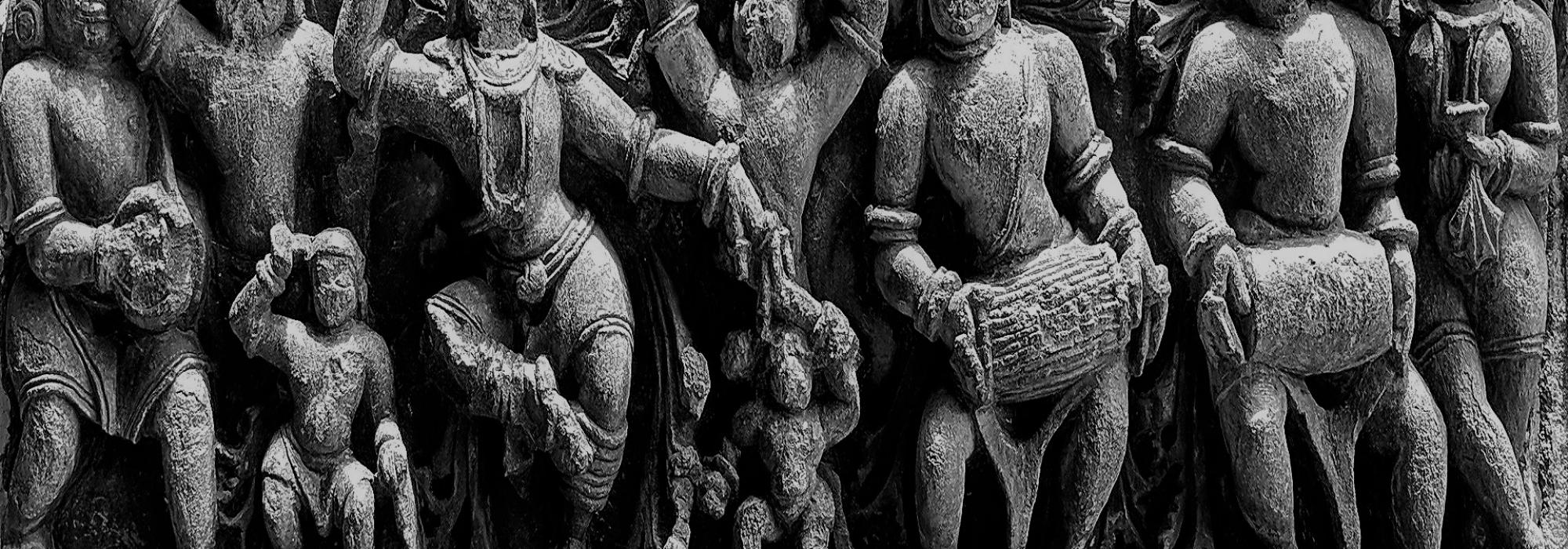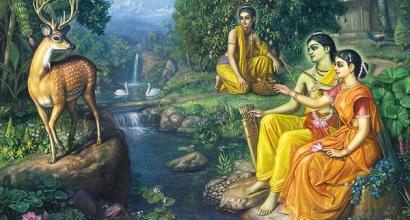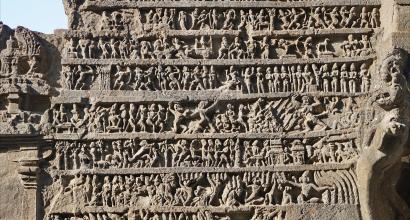The mind and the intellect (manas and buddhi) are the two-primary means by which a man perceives the world and lets himself be perceived.
The eyes, the ears and other senses, and the parts of the body that shelter them become the instruments for the above two.
Training in arts strengthens the mind through refinement and the intellect acquires a refined strengthening through the knowledge of śāstras (roughly translated as ‘sciences’).
Art evokes the soft and tender emotions of the heart and gives it a form; it helps us in sculpting our behaviour and conduct and makes them more subtle and nuanced. There are four main forms of art: i. Kāvya (poetry, literature), ii. Saṅgīta (music), iii. Nāṭya (drama, dance), and iv. Citra-śilpa (drawing, painting, sculpture). In dance, there are two major classifications – Nṛtta (non-referential dance which does not communicate a specific theme; instead focuses only on beautiful movements of the body as the means of enjoyment) and Abhinaya (referential dance, the purpose of which is to communicate a specific theme through the body movements, verbal/musical expression, external embellishments and emotions).
Hailing music and drama/dance as ‘Gāndharva-veda’, our ancestors have given them a status close to that of the Vedas. We find references to saṅgītā (music) in the Vedas itself. Music is an essential part in ritual sacrifices such as the Rājasūya-yajña as well as in traditional cultural practices or rituals like Sīmantōnnayana and so forth. Thus, music and dance are honourable forms of knowledge. Gandharvas, Vidyādharas, and Apsarās are the presiding deities of music and dance.
Svarveśyā ūrvaśīmukhāḥ II
- Amarasiṃha
Amarasiṃha <footnote> has called Urvaśī and other Apsarās the Veśyās (courtesans) of Devaloka (home of the gods). There is a reference to Urvaśī in the Ṛgveda (X.95)
Devendra used to send his Apsarās to the earth in order to disturb the penance of those who would undertake them in the fear that they would become his competitors in Svargaloka (heavens).
Likewise, the story of Menakā and others disrupting the penance of Viśvāmitra is well known.
Realizing that the presence of Ṛṣyaśṛṅga was an absolute necessity for the success of the Yajña being conducted by King Daśaratha, he appointed Veśyās to allure Ṛṣyaśṛṅga. – a story delineated in Śrīmadrāmāyaṇa.
Thus, we see that the profession of such Veśyās (prostitutes) has been there since ancient times. An English adage calls it the oldest profession in the world.
Harlotry clans were found in ancient Greece as well. The moral society there had not yet dismissed that profession. It was the practice of the people in Greece to have partners or companions as mistresses (Hetaera).
A famous prostitute among the Greeks was one Aspasia. She was the paramour of the famed statesman Pericles of the city state of Athens. Apart from being beautiful, she was well-educated, a connoisseur, and intelligent. It is said that Pericles deliberated the matters of the state with her as well. Her home was a place of entertainment for the eminent people of Athens. It is believed that the world-renowned philosopher, Socrates, also visited her for discussions.
The Legacy
It is said that great seers such as Mataṅga and Bharata, are the founders and propagators of the science of music and dance, which have descended as a hereditary household occupation of a group of people in our ancient systems.
Is it not true that in the social system of the past, a purohita, an accountant, a village head, a washerman, a barber, a scavenger, a watchman, etc. inherited their ancestral duties? So was the case with dancers. Naṭṭuvāṅga (the traditional system of playing on cymbals as a guide to the dancer) is also an inherited profession.
The word ‘naṭuva’ along with those such as Naṭana, Nāṭya etc. have the same group of root words. Since the dancers were mostly women, it has become customary to call them Nartakī, Gāyakī, Veśyā, Vārāṅganā, Devadāsī, Nāyakasānī and by such other names. The one who was renowned for her singing, dancing and for being virtuous, was called as ‘Ghana Nāyakasānī’. In some of these names instead of the mention of music or dance, we predominantly get the undertone of prostitution that got attached to those art forms. Such names are not particularly agreeable because they reveal a human’s fickle-mindedness. Hence, let us use the words ‘Naṭuvaru’, ‘Nāyakasānī’ and ‘Devadāsī’.
In early days temples were responsible for their profession gaining the respect they deserve. Since ancient times, offering of dance was an essential part of the festivities taking place both inside and outside the temple. The primary intent behind vigrahapūjā (roughly understood as idol worship) is that a devotee offers his endearing fortunes to the Supreme, is it not? It is by the grace of the Supreme that he has received all that which he likes, enjoys, and gives him happiness; the ability to experience these is also by Divine grace. The Supreme is the all-authoritative power for each and every aspect of human beings. Hence, it is only fair and natural that any enjoyment that one experiences must be surrendered to the Supreme at the outset. However, the Supreme is not a tangible possession that can receive something. Ergo, the devotee offers his worldly luxuries to an image of the deity, which is a representative of the Supreme. In this way, music and dance became surrendering entities. Therefore, music and dance were taught by the artistes in order to enable offering service to the Supreme.
Adequate Education
The art of dance is one of the sixty-four arts that has been accredited with sciences and traditions and finds a place in many Vedic activities. All and sundry could not become dancers.
- The one who is a notable dancer according to the sciences and traditions must be a Naṭuviti by birth
- She must have been initiated in Bharata’s art from a befitting Guru (preceptor/teacher).
- Once she has been accepted by the Guru as being knowledgeable, she must duly get her anklets (gejje) worshipped by the family purohita, which is the norm. During the time of the performance, she must regard the anklet chains, the cymbals, maddaḷe (a traditional percussive instrument used by dancers of that period) and other instruments as a reflection of the Supreme; then she must place an urn (kalaśa) and a mūrti of goddess gaurī made from turmeric (arśinada gaurī) and worship them meticulously; she must then accept the gejje from the purohita, offer fees (dakṣiṇā) to her guru and must distribute sandal paste (gandha), flowers (puśpa) and betel leaves and other customary offerings (tāmbūla) to the gathering.
- Once the worship is completed, she must go the temple where she is to adorn the anklets and dance in the presence of the deity.
Like this, her first performance takes place in the presence of the Supreme. Prior to this, she was not to perform in public.
Thus, dance became a respectable form of knowledge with its set of assigned duties and the boundaries of sciences.
A glorification of the art of dance is found in Kalidasa’s drama, Mālavikāgnimitra and many more ancient works. In the Mahābhārata, during the period of incognito spent by the Pāṇḍavas, Arjuna taught dance as Bṛhannala, is it not? Like this, dance is very ancient in our culture.
Opposition to Dance
Thus the dancers’ clan can be traced to ancient times. The inherent fickle-mindedness of man caused a blemish to this race. Without considering this, some nationalists caused an adversity to the age-old profession during the initial years of the current century. Among the social reformers were many scholars, thinkers, visionaries and insightful persons; Raja Rammohan Roy, Mahadev Govind Ranade, Ishwarchandra Vidyasagar, Ramkrishna Gopal Bhandarkar – belong to this line of greats. Since they were all famous as senior scholars and noblemen, their debates and preaching happened to receive high laurels in the country. However, to a few among them, some of their new notions must have occurred in a fit of impulse. Among those unmindful opinions, the opposition to dance is also one such.
This somehow grabbed the attention of the rulers of Mysore. During the period of Sir K Sheshadri Iyer and the Muzrai department head, Arcot Srinivasacharya, the service of the Devadāsīs in the temples, in relation to its administration, was stopped. Observing the fifty to hundred years prior history of just that time, anyone was bound to feel that there were enough reasons to stop the Devadāsī tradition. It is true that the authorities, priests and Devadāsīs of many temples took disadvantage of that profession. When the procession was being taken out in many of the temples, the groups of people would be found crowding around the Tāfās (a technical term used as a synonym to Devadāsī) rather than the deity, which was the main concern. On special days such as Mukkoṭi Ekādaśī, Vairamuḍi, Kalyāṇotsava etc, how many persons would come to see the deity and how many to see the Tāfās…who knows!
Thus, when we look at just the experiences of some time periods, no one would feel that what Srinivasacharya did was wrong. When it did happen, many agreed that it was a good injunction. While a good reform did happen; a good knowledge system got lost.
A few years after this reform took place in Mysore, a movement for the same spread out in British occupied India as well. The famous High Court Judge at Bombay, Sir Narayana Chandavarkar, his friend and editor of ‘Social Reformers’ newspaper K Natarajan and others began the Anti-Nautch Movement. I must have been fifteen or sixteen years of age then. I too joined that movement. As identification of that vow, I tied a black thread to my forearm.
To be continued...
This is the first essay in D V Gundappa’s magnum-opus Jnapakachitrashaale (Volume 2) – Kalopasakaru. Thanks to Hari Ravikumar and Arjun Bharadwaj for their review
The term used by the author through out the article is ‘Nāṭya’ which, in its technical definition, refers to ‘theatre’. Theatre does encompass in itself the art forms of dance, music and such other fine arts. However, when we look at the writing in its entirety, the author has used the term Nāṭya synonymous to refer to Nṛtya or Dance. Hence, the term ‘Dance’ and its suitable grammartical forms has been adopted throughout the article.
















































